The CCC should advise Government that …
1. The Paris Agreement sidelines the cumulative effects of global warming like sea level rise, very intense storms and melting tundra.
2. Climate models with missing climate feedbacks should not be used in policy formation.
3. The UK’s proposal for measuring greenhouse gases changes the definition of net-zero emissions in a perverse way.
This piece doesn’t mean I don’t appreciate the work of the
Committee on Climate Change – in what I imagine are difficult circumstances.
Earth’s Energy Imbalance and Greenhouse Heating
All the energy that enters or leaves the Earth does so via radiation at the top of the atmosphere. Before the Industrial Revolution, usually assumed to start in 1750, incoming radiation was balanced by outgoing radiation (with the exception noted in Deeper Earth below). Since then, triggered by emissions of greenhouse gases, less energy is leaving the Earth than entering, causing the Earth’s Energy Imbalance (EEI), which has been described as “the most fundamental metric defining the status of global climate change”.
Here, the Earth’s Energy Imbalance will be referred to as ‘greenhouse heating’ and the extra energy stored in the Earth since 1750 will be referred to as ‘greenhouse heat’. The extra energy is stored as heat. This includes latent heat that has melted ice.
A simplified thermal model of the Earth
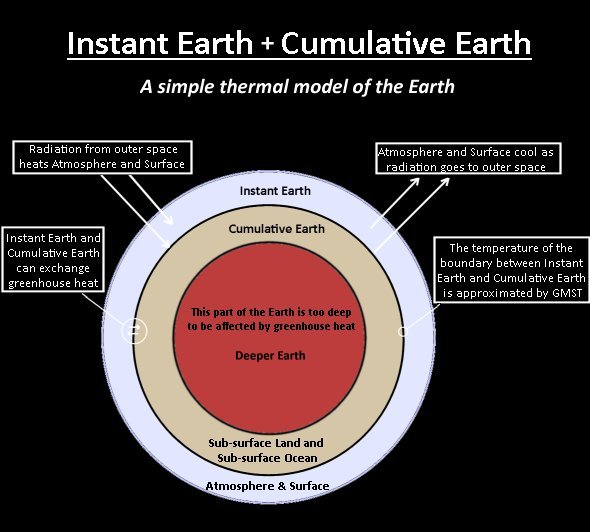
The simplified model used in this note divides the Earth in three parts: Instant Earth, Cumulative Earth and Deeper Earth:
- Instant Earth can receive and emit radiation to outer space. Its temperature reacts quite quickly to changes in Earth’s Energy Imbalance because it has low thermal capacity. It is made up of the atmosphere plus a surface thickness of ocean and land.
- Cumulative Earth can only exchange greenhouse heat with Instant Earth. The temperature of Cumulative Earth reacts slowly to heat from Instant Earth because it has much higher thermal capacity. Cumulative Earth is sub-surface ocean and sub-surface land.
- Deeper Earth is that part of the Earth, which is too deep to be reached by greenhouse heat. There is, however, a steady flow of heat from this core part of the Earth to outer space via Cumulative Earth and Instant Earth. The flow is a steady one, superimposed on the heat flows caused by the Earth’s Energy Imbalance. It is ignored in this note.
The surfaces of ice masses have characteristics of both Instant Earth and Cumulative Earth: Instant Earth because ice masses can receive and emit radiation, but when they melt, they absorb energy, without much rise in temperature. A slow rise in temperature in response to greenhouse heat is a characteristic of Cumulative Earth. Also, most of the melt water joins the ocean. The vast bulk of the ocean is sub-surface, part of Cumulative Earth.
Global Mean Surface Temperature: Instant and cumulative effects.
The usual measure of the Earth’s surface temperature is called Global Mean Surface Temperature (GMST). To get a value for GMST at a specific time, temperatures from measuring stations are combined to form average values. There have been different schemes for averaging measurements, accounting for the uneven geographical spread of measuring stations.
In this simplified thermal model, GMST can be identified as the temperature of the lowest part of Instant Earth. It governs the rate of transfer of heat to Cumulative Earth. GMST is balanced between greenhouse heating and the cooling from heat being transferred into the sub-surface ocean.
Earth’s heat content and stored CO2.
Carbon dioxide is the gas that causes most greenhouse heating: It, and other greenhouse gases form a one-way blanket letting less radiation to be radiated to space than is coming in.
Considering the effects of CO2 alone in climate models, it has been found that there is a simple relationship between emissions of CO2 and the rise in GMST that results. The simplicity is that the rise in GMST is independent of when the CO2 is emitted. It depends on the fact that once emitted the greenhouse heating caused by CO2 remains for a very long time.
A gigatonne of CO2 emitted now, in 2020, causes a rise in GMST. This rise in temperature is a step up, which persists for centuries to millennia, independent of further emissions. This result is a surprise because there are two separate influences on GMST:
- As time goes by, CO2 passes from Instant Earth (mostly in the atmosphere) into the sub-surface Cumulative Earth.
- Also, as time goes by, heat from Instant Earth warms Cumulative Earth, increasing its temperature.
Influence 1 reduces surface temperature, GMST, by reducing CO2 in the atmosphere, reducing greenhouse heating. Influence 2 increases GMST by reducing the flow of greenhouse heat from Instant Earth to Cumulative Earth.
Climate models have found that these two influences balance each other. This means that a given pulse of CO2 emissions will quite quickly raise GMST, but this increase will only decay slowly over millennia. To emphasise: The influence on GMST of less CO2 in the atmosphere is balanced by less greenhouse heat being transferred from Instant Earth to Cumulative Earth. This is shown in Figure 2(b) in The proportionality of global warming to cumulative carbon emissions.
The greenhouse heat in Cumulative Earth has been accumulated since 1750 from heat transfers from Instant Earth. In addition, Cumulative Earth stores large quantities of CO2 that has been passed from the atmosphere.
In short: Extra CO2 in the atmosphere increases these (in Instant Earth):
1) Greenhouse heating aka Earth’s Energy Imbalance,
2) GMST, Earth’s surface temperature.
These are effects in Instant Earth but extra CO2 added to the atmosphere since 1750, (‘greenhouse CO2’), has caused the accumulation of the following to accumulate in Cumulative Earth:
3) Heat stored in Cumulative Earth via GMST, and
4) Greenhouse CO2 stored in Cumulative Earth.
The greenhouse CO2 stored in Cumulative Earth is the cause of ocean acidification. It also slows the transfer of CO2 from the atmosphere, extending its effect on greenhouse heating.
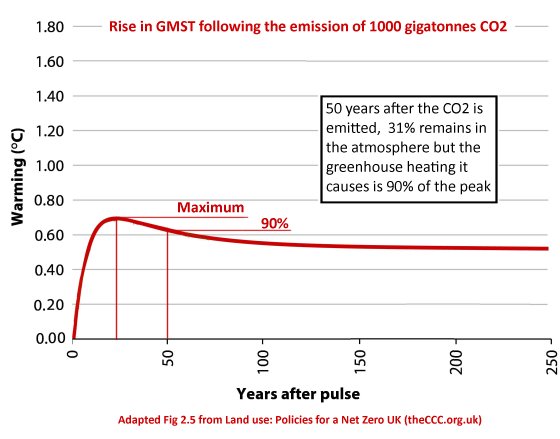
These processes are described in The proportionality of global warming to cumulative carbon emissions by Matthews et.al. Note Figure 2(b), which shows the half-life of a pulse of CO2 in the atmosphere of roughly 30 years. Accordingly, 50 years after the CO2 is emitted, 31% remains in the atmosphere but greenhouse heating it caused is 90% of the peak.
Other greenhouse gases and GMST
Other greenhouse gases contribute to the Earth’s Energy Imbalance: Methane (CH4) is the most important. Nitrous Oxide is another of lesser importance.
Significant amounts of methane are emitted by human activity: Emitted in fossil fuel extraction and processing, farming beef and lamb, and growing crops in paddy fields. On a molecule by molecule basis, methane has a much more powerful warming effect than CO2, but its concentration in the atmosphere is lower so it has a lesser effect than CO2. In 2020, the greenhouse heating due to methane is currently about 60% of the heating due to CO2.
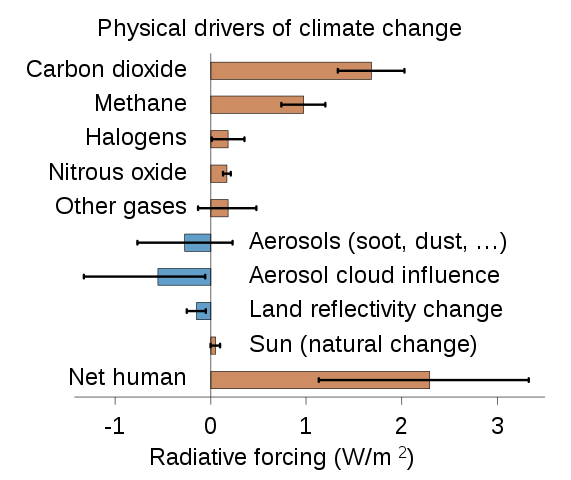
IPCC (2013) Climate Change 2013: The Physical Science Basis
Due to chemical processes in the atmosphere driven by sunlight, methane decays in a few decades: It has a half-life of 9.1 years. While it is in the atmosphere, it increases Earth’s Energy Imbalance and raises GMST, transferring heat into Cumulative Earth. After it decays, its effect on GMST reduces, but there is some continuing effect due to the increased heat it caused in Cumulative Earth: A large part of this is Ocean Heat Content.
The greenhouse warming (i.e. effect on the Earths Energy Imbalance) reaches a maximum in about 12.5 years. At this time more than half of the methane has disappeared.
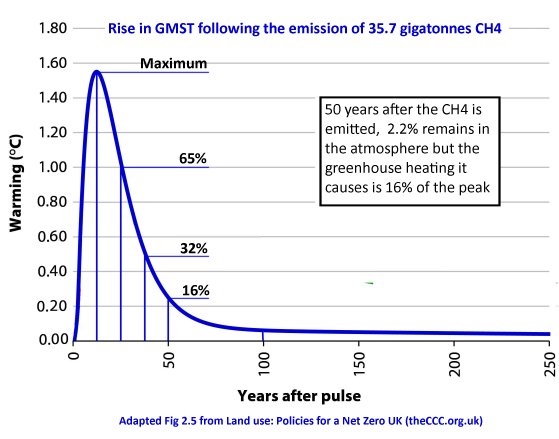
Emissions of CH4 now, in 2020, will still have 16% of its maximum effect on GMST 50 years later even though only 2.2% of the gas will remain in the atmosphere..
Instant and Cumulative Climate Effects
The greenhouse effects in Instant Earth include heat waves, floods, droughts and storms. These effects are strongly related to GMST so setting a maximum level of GMST sets a limit to the maximum intensity of these ‘instant’ effects of climate change. These instant effects are, of course, serious.
However, there are also effects seen in Cumulative Earth, which have serious consequences too: melted ice, thawed tundra, sea level rise, very intense storms and ocean acidification. These are effects that accumulate and some have been accumulating since 1750. They also have other serious consequences. For example, the warming of sub-surface permafrost in tundra (and ocean floors) is being recognised as a source of serious carbon cycle feedbacks. In addition, changes in ice masses cause albedo feedbacks, and important feedbacks are badly represented in climate models. These feedbacks raise GMST making the effects in Instant Earth worse.
However, because the effects in Cumulative Earth are slower moving, they are less newsworthy than the effects in Instant Earth. The hurricanes and wildfires in Instant Earth trump the slow build-up of sea-level rise, permafrost thaw and melting glaciers in Cumulative Earth.
The instant becomes cumulative
In politics and the scientific literature, the concern for climate change has been led by a concern for a peak value for GMST. When the peak is assumed to occur in a particular year (or few contiguous years), attention is diverted away from other years where climate damage may be high but not at the peak.
However, there are the climate effects of Instant Earth, which take place over an extended period and become cumulative effects like cumulative death toll, economic damage, loss of biodiversity.
To frame climate policy using one moment in time – the time when GMST reaches a peak value – sidelines cumulative damage and the dangers of a prolonged period of greenhouse heating. Such a framing diverts policy discussions from cumulative effects.
Peak GMST and heating Cumulative Earth
Many policy discussions on climate change are about keeping peak GMST below a certain level. A typical value used to be 2°C above pre-industrial times (1750 assumed above). Peak temperature is often assumed to occur towards the end of this century. For ease of explanation, this note will assume this time is the year 2070.
The effect mentioned above – the balance between hotter oceans and reduced atmospheric CO2 – means that a pulse of CO2 emitted in 2020 will cause the same GMST increase in temperature in 2070, as a similar one emitted in twenty years’ later, in 2040. To use a plausible example, consider two different cases showing the possible effects of 400 billion tonnes of CO2 being emitted. (400 tonnes CO2 is roughly 10 years of current emissions) :
- 400 Gt CO2 is emitted in 2020 causing a rise in in GMST of 0.20°C
- 400 Gt CO2 is emitted in 2040 causing a similar rise in GMST of 0.19°C
These increases in GMST remain more-or-less unchanged for millennia. However, in case of 2020 emissions, the extra twenty years of extra greenhouse warming will have transferred heat to Cumulative Earth – mostly as Ocean Heat Content.
For the ‘peak temperature’ date of 2070, these two cases show a small difference in GMST, but in the case of emissions in 2020, the extra twenty years of greenhouse warming will have stored greenhouse heat in Cumulate Earth.
The effect of methane is different. As noted above, its shorter lifetime means that after it is emitted, its effect on GMST is significantly reduced in 50 years, but it leaves increased heat in Cumulative Earth.
Carbon Capture and Storage has similar problems. Even if it were to be possible to extract CO2 from the atmosphere to reduce its residency, emitting CO2 and then removing it in a few decades would still leave decades of greenhouse heat stored in Cumulative Earth.
The Paris Agreement is missing cumulative effects.
The target of the Paris Agreement is that global temperature should not rise past a certain limit, during this century. It says:
The Paris Agreement central aim is to strengthen the global response to the threat of climate change by keeping a global temperature rise this century well below 2 degrees Celsius above pre-industrial levels and to pursue efforts to limit the temperature increase even further to 1.5 degrees Celsius.
It is usually assumed that ‘global temperature’ can be interpreted as GMST. In discussions on climate change a typical date for reaching peak temperature might be taken as 2070.
There have been some uncertainties in the Paris Agreement, such as different definitions of GMST, and possible differences in the meaning of pre-industrial. These uncertainties have been resolved more-or-less satisfactorily. The meaning of ‘well below 2 degrees Celsius’ was purposefully vague but assume, for the purpose of explanation, it means 1.7°C.
The Paris Agreement is a ‘peak temperature’ agreement, which means that any scenario of emissions that keeps GMST below 1.7°C is allowed. The effects in Instant Earth at peak GMST are clearly serious: A few years at peak temperature, even if constrained to 1.7°C, will cause problems: enhanced storms, heat waves & etc but cumulative effects that build up over years must be taken much more seriously.
- Cumulative climate death toll.
- Cumulative economic damage.
- Cumulative loss of biodiversity.
- Extended periods of drought.
- Ocean acidification.
- Wildfires.
- Sea-level rise.
- Permafrost thaw.
- Melting glaciers.
- Ocean warming.
It has been noted above that short-term greenhouse heating by methane emitted now does not affect GMST substantially by 2070. These emissions of methane will cause some increase in GMST, but, more significantly, will heat Cumulative Earth, causing seas to rise and feedbacks to trigger.
An optimistic business friendly paper
An interesting paper is : Current fossil fuel infrastructure does not yet commit us to 1.5°C warming (2019) by Christopher J. Smith,, Piers M. Forster, Myles Allen, Jan Fuglestvedt , Richard J. Millar, Joeri Rogelj, & Kirsten Zickfeld.
Piers Forster is a member of the Committee on Climate Change and Richard Millar is the Committee’s Senior Analyst for Climate Science. The abstract contains
Here we show that if carbon-intensive infrastructure is phased out at the end of its design lifetime from the end of 2018, there is a 64% chance that peak global mean temperature rise remains below 1.5°C.
This means to keep within the lower limit of 1.5C in the Paris Agreement, it is not necessary to shut fossil fuel infrastructure before the end of its design lifetime:
In our central scenario, CO2 emissions are phased out from the end of 2018 at a close to linear rate… In these scenarios, fossil fuel power plants, cars, aircraft, ships, and industrial infrastructure are replaced with zero carbon alternatives at the end of their life.
This looks like good news for business interests (and the UK business department, BEIS?). The authors use a simplified climate model, FAIR (Finite Amplitude Impulse Response Model), to calculate increases in GMST from the greenhouse gas emissions. However, the model excluded
the possibility of strongly amplifying carbon cycle feedbacks such as permafrost melt or forest dieback, which are not included in our model,
Worryingly, neither the paper, or the documentation for the FAIR model, mention albedo feedback or sudden ice sheet collapse.
It should be noted that this paper is concerned with keeping GMST below 1.5°C and is relevant to the year or so of this peak temperature and the effects in Instant Earth. This sidelines the effects in Cumulative Earth, like ice sheet collapse, the thawing of permafrost in the Arctic, the drying of regions of the world causing increased wildfires.
Current news indicates that the climate situation is much, much worse than this optimistic business friendly paper suggests. See the Appendix, A few tweets on Twitter.
New CO2 metrics: Changing the goal posts.
The CCC’s publication Land use: Policies for a Net Zero UK says:
A new usage of the GWP 100 metric (named GWP*) has recently been developed to recognise the difference in how sustained emissions of methane and CO 2 /N 2 O affect global average surface temperature, which is not fully captured by the current metric.
This new usage has been proposed in the paper and A solution to the misrepresentations of CO2-equivalent emissions of short-lived climate pollutants under ambitious mitigation. It uses the rate of change of emissions of methane combined with the emissions of CO2 in a novel way.
This new metric is not fundamentally about climate science, it is about the politics and the standing of international agreements. As the CCC says:
This new metric will be assessed by the IPCC as part of its forthcoming 6th Assessment Report.
An important question is: “How does this new metric affect the target of net-zero emissions?”. A diagram in the paper Climate metrics under ambitious mitigation from the Oxford Martin School:
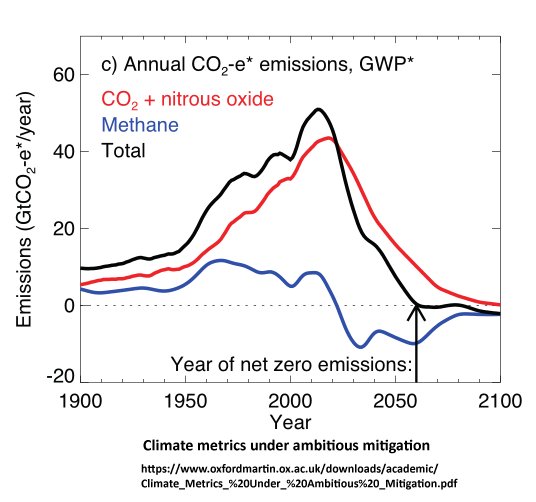
This new metric GWP* gives a net zero emissions when CO2 emissions are not zero and still significant.
This image surprises. In 2060:
- GWP* is net-zero
- CO2 emissions ~10 Gt/yr
- CH4 emissions non-zero
Most people would think net-zero in any version of GWP would have zero net-CO2 emissions. We’ve caught up to the fact that net-zero doesn’t really mean zero CO2. (Remember Greta Thunburg saying ‘Forget about net zero, we need real zero‘?)
Is net-GWP* even worse ???
If this is correct it’s business friendly and just what the CCC’s sponsoring department (the Department of Business, Energy and Industrial Strategy) might like. Change the goals posts: Reach a new net-zero without cutting CO2 emissions or CH4 emissions to zero.
Conclusions
Elsewhere, I have commented on the political constraints on the committee, Free the Committee on Climate Change (Apr 2019), and the position of the UK business department being in control of science policy, Take climate policy from the UK business department (Jul 2020).
I know the surrounding politics of the CCC is recognised: I have heard Lord Deben say that there are political limits to what can be achieved (Sep 2014). However, the fog of climate information is clearing and the CCC should raise three things with the UK Government:
- The Paris Agreement sidelines important cumulative climate effects.
- Models with missing climate feedbacks should not be used in policy formation.
- The UK should not promote the use of GWP* to the international community, without disclosing that net-zero GWP* is not zero CO2 or zero CH4.
Postscript 23rd September 2020 : Paper on Earth’s Energy Imbalance
Just found this important paper,published two weeks ago.
Heat stored in the Earth system: where does the energy go?
” This Earth energy imbalance (EEI) is the most critical number defining the prospects for continued global warming and climate change. Understanding the heat gain of the Earth system – and particularly how much and where the heat is distributed – is fundamental to understanding how this affects warming ocean, atmosphere and land; rising surface temperature; sea level; and loss of grounded and floating ice, which are fundamental concerns for society. “
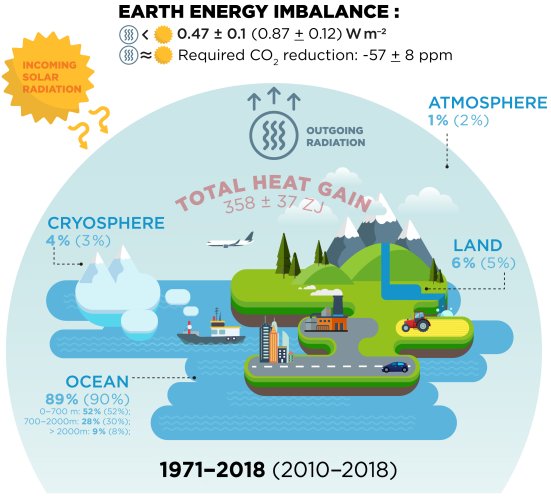
A few tweets on Twitter
Wildfires in Siberia threaten us all
Sea levels accelerating
Siberian permafrost thaws
African droughts
The tipping points at the heart of the #ClimateCrisis
Floods in Greece
Climate affects the USA
Californian Fires
